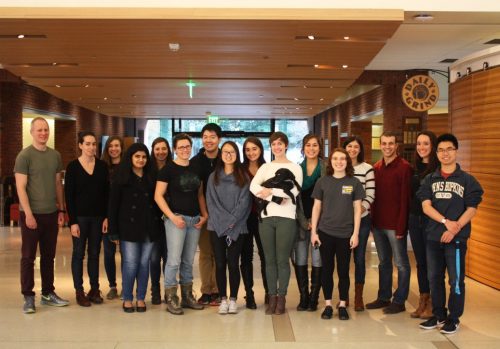The role of thyroid hormone and in cone cell development
The sprawling red, orange, and yellow trees on Yale’s campus in the Fall are a treat to our visual senses, thanks to the photoreceptor cells in our eyes known as cones. The six million cone cells in the retina of a normal human eye, responsible for our color vision, are what allow us to take in the beauties of autumn. Our color vision is so central to our daily lives, but the specifics of how and when this system develops remains a mystery.
The Johnston lab at Johns Hopkins University has found a new way to tackle these important questions about our eye—by growing human retinal organoids from scratch in order to model the light-sensitive layer in the eye called the retina. Their model system allows them to study color vision and its development within the womb. By replicating the development of a human’s color vision in the womb and establishing a role for thyroid hormone in the development of the eye, they plan to apply their research towards better understanding eye diseases.
The main goal of the Johnston lab’s recent study was to determine when and how the three types of color-sensing cone cells—red, blue and green—were made in the retina. However, prior research had yet to find a model that translated directly to the human body. Human organoid technology, which Professor Robert Johnston first learned about at a conference several years ago, became their hope to better understand photoreceptor development in the eye.
Lead author on the study Kiara Eldred added a series of different signals to pluripotent embryonic stem cells—cells in the body that are able to develop into other specific cell types—and induced them to become human retinal tissue. After 40 days, they removed all the inducing signals and allowed the organoids to grow on their own set path in media. Over the course of nine months, these retinal organoids became small pieces of tissue that resembled and behaved like real human retina tissue.
Based on prior animal research showing that thyroid hormone receptor was important in the development of characteristics of the cone cells, the researchers hypothesized that the thyroid hormone would similarly play a role in cone cell development in humans. Eldred grew the retinoids for a full year, picked the tissues out at different timepoints along the way, and took pictures of what cells were there to determine when cone types developed. They verified that the organoids were a good model system because it showed what was expected in fetal development—that blue photoreceptor cells develop first, followed by the red and green cells.
Genes that degrade the thyroid hormone were found to be expressed early in development of the retinal organoids, giving rise to blue cells, while other genes that activate thyroid hormone were expressed later to give red and green cells. In essence, they learned that the retina itself controlled levels of thyroid hormone, and that the increase in thyroid hormone levels determined the trajectory of cone cell development in the eye.
The study was a tedious process. Eldred had to carefully grow these organoids under the right conditions for a full year, all without antibiotics, making them exceptionally vulnerable to infection and contamination. Just as nurturing the growth of a baby during pregnancy takes the right personal care and complex natural combination of hormones, nutrients, and conditions within the womb over a full nine months, growing these retinal organoids from scratch was a challenge. In fact, this was the hardest part of the research because it was the first time anyone has used organoids to work on mechanisms of human eye development.
“What I’m proud of with this project is that this system grows on its own, so when you perturb it, it gives you a very good idea of what’s happening in real humans, because you can’t do experiments on humans,” Johnston said.
The lab next wants to investigate what mechanism controls thyroid hormone levels within the retina. Understanding this may lead them a step closer to being able to restore color vision to people who are colorblind and who lack these photoreceptors. They are collaborating with others at Johns Hopkins University to deliver these organoid-based cell types into humans and hope to be able to deliver different types of photoreceptors to particular parts of the eye that may lack them. Their retinal organoids may just be the first step to understanding and eventually controlling one of the most unique functions of the human eye—color vision.

